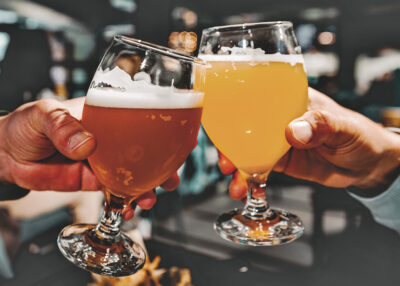In a word, yeast. These brews are made from two different kinds of yeast.
Ale
Brewing an ale requires a yeast species named saccharomyces cerevisiae, also called “top-fermenting” because as the yeast consumes malt-derived sugars, it rises to the top of the vessel. Ales are fermented at warm temperatures (60˚–70˚F). This range keeps ale yeast productive, encouraging more fruity aromas such as pear, apple, and even rose.
Depending on the strain of saccharomyces cerevisiae, these yeasts can produce IPAs, wheat beers and Belgian styles.
Lager
A lager is “bottom fermented” and uses a yeast called saccharomyces pastorianus. Lager yeasts are fermented in lower temperatures – generally between 42–55 ºF. Overall, it’s a slower and calmer process. Lager yeast sinks to the bottom of the vessel, as compared to ale yeast, with its warmer fermentation, is more active and blasts to the top. The prolonged fermentation results in fewer byproducts (like esters). This tends to play into the perception that lagers are crisper than ales.
The most distinct lagers include Czech- and German-style pilsners, Dunkels and India Pale Lagers (IPLs).
But Wait, There’s More!
Lager is a noun (which translates from German as “storage”), but it’s also a verb that refers to the cold storage of beer while it ferments. Basically meaning, this is going to take awhile! Besides the yeast, lagers traditionally require more time to brew than ales.
There’s also a difference in taste in most cases. Ale yeasts produce more esters and phenols during fermentation, which are byproducts that give beer those non-hop, non-malt flavors. This is in direct contrast with the clean, crisp flavors and aromas of beer fermented with lager yeast.
Taste Test Tips
So now that you know the basics:
- Ales and lagers are made with different species of yeast
- Ale yeast tends to ferment better at warmer temperatures, and lager yeast at cooler temperatures
- Generally, you can taste the difference by looking for the fruity or spicy characteristics of an ale
It’s time for some homework! Try our selection of the two brews, including our Druthers Gold Lager, Golden Rule Blonde Ale and the Golden Rule Pilsner.
Cheers!
